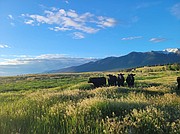Brothers return to ranching roots to teach next generation
Through teaching an agriculture and construction class at Whitefish High School for the last four years, educator Mark Casazza has watched struggling students transform into attentive and motivated workers.
“[The class offers] room for adaptation,” Casazza said in a recent interview in his classroom. “Kids who are struggling in school have the opportunity to change paths.”
Now, Casazza is launching a post-secondary trade school, with the intention of training the next generation of construction and agriculture teachers for Montana public schools.
Casazza has dubbed his new program Truth, Trades and Technology, and he is starting it with two of his former students, Jacob Ramsey and McKenna Ferril. Ramsey and Ferril will be half of the school’s four-person inaugural class, as well as serve on the nonprofit's board of directors.
For Casazza, the program serves multiple purposes. It offers kids a different educational path out of high school – one that will leave them with two teaching endorsements and estimated earnings of $200,000 – instead of a college degree and piles of student loan debt.
He also sees it as a pipeline to getting endorsed construction and agriculture teachers into other public school classrooms around Montana.
According to Casazza, teachers previously had to log 10,000 hours in a related field to receive a public education endorsement from the state. Gov. Greg Gianforte has recently reduced the requirements to 5,000 hours per endorsement, which will allow Cassaza’s Truth, Trades and Technology program to offer two endorsements – building trades and agriculture business – during their five year curriculum.
The students will take on a wide variety of work as part of their education. For the building trades side, they will learn skills such as carpentry and cement pouring.
AS PART of the business agricultural education, the students will be spending most of their time on Cassaza’s brother Eric’s ranch in Eureka, learning the ins and outs of ranching. Student responsibilities will include irrigation, fence construction and maintenance, feeding and corralling cattle. The program plans on adding lessons about slaughtering, butchering, smoking, packaging and marketing.
The brothers grew up on a ranch in Eureka, but each went to college and pursued different careers.
Mark became a math teacher, and Eric had a 30 year career in the oil industry before moving back to Eureka to pick up ranching.
Mark says his programs wouldn’t be possible without his brother’s land and permission.
Eric is expanding the ranching operations, turning it from a hobby that ties him to his upbringing into what he describes as a part-time job.
He recently received a $250,000 grant from the United States Department of Agriculture to expand the ranch’s meat production and processing capacity.
The grant award is part of the the department’s Value-Added Producer Grant program, is intended to help small producers compete in an increasingly centralized meat-production industry.
“Every day, consolidation in the ag industry is putting small processors out of business,” said Democratic Sen. Jon Tester in a statement. “These grants will ensure that our small business owners have the resources they need to stay competitive, while creating jobs and lowering costs for producers and consumers.”
Eric Casazza’s ranch, E&S, was one of seven Montana meat producers to get a slice of $1.1 million in federal funding. E&S received the maximum allotment, though Eric Casazza described the grant-writing process as long and involved.
According to him, the money made expansion of his ranch economically viable.
He currently raises 30 steers at a time, but expects to expand over the next two years to a total of 70.
To get to that point, Eric Casazza will use most of the funds to invest in the ranch’s infrastructure, including fences, preparing additional pastures, buying hay and perhaps building a barn.
He said the USDA has implemented the program to try to preserve the way of life for small ranchers and farmers.
“They’re doing this grant because people are growing up on the ranch and quitting,” said Eric Casazza in a recent interview, pointing out that kids these days are often choosing more secure ways to make a living. “There’s not a lot of people who want to go into agriculture anymore.”
He said that the ranch life is tough, but that watching steers grow fat and providing meat to his community is a fulfilling endeavor.
“I grew up on a ranch, so I love it,” Eric said. “My neighbors too, it’s in their blood. They’re third or fourth-generation ranchers but they have other jobs that keep the lights on.”
The two former students, Jacob Ramsey and McKenna Ferril, both saw themselves heading in a different direction, but have now come aboard for the program.
“I didn’t see myself teaching,” Ramsey said. “I saw myself in law enforcement or the military. I gave my old teacher a call and said ‘I need something to do, I need direction.’”
“I was going to go to college and study biochemistry,” said Ferril, who added that he has enjoyed learning about the subject in an applied setting.
“It’s so rewarding that these kids get practical working experience,” said Mark Casazza. “Anyone can be a teacher now.”
Ferril is getting his hands dirty and picking up skills that may have been common in the past – but that most students go without in today’s Zoom age.
“I’ll have my own ranch and build my own house,” predicted Ferril. “It’s not a dream, it’s a reality.”




